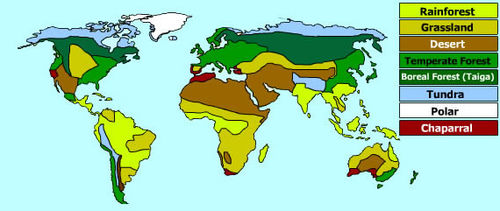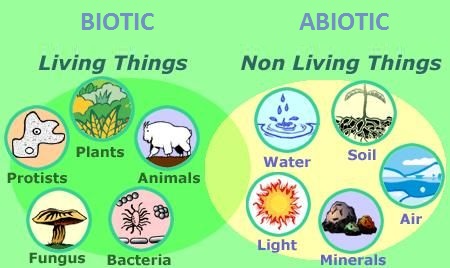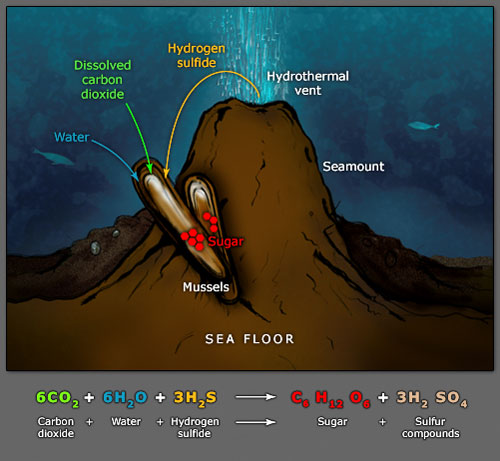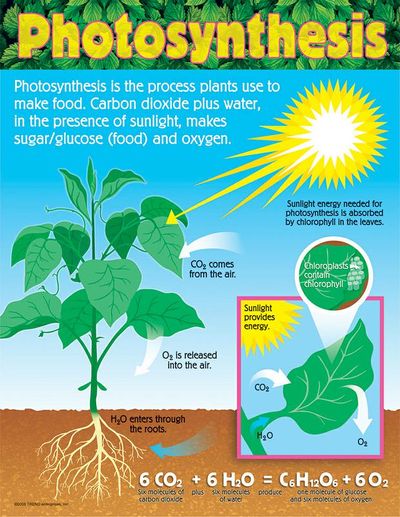Terrestrial ecology: Difference between revisions
| Line 101: | Line 101: | ||
Forseth, Irwin N. 2010. "Terrestrial Biomes" https://www.nature.com/scitable/knowledge/library/terrestrial-biomes-13236757 | Forseth, Irwin N. 2010. "Terrestrial Biomes" https://www.nature.com/scitable/knowledge/library/terrestrial-biomes-13236757 | ||
Gale, World of Biology. 2006. April, 3. "Heterotroph." http://link.galegroup.com/apps/doc/CV2431500310/SCIC?u=sunybuff_main&xid=90cec2db. | |||
Lerner. K Lee. Lerner. Brenda Wilmoth. 2014 The Gale Encyclopedia of Science. "Autotroph." http://link.galegroup.com/apps/doc/CV2644030216/SCIC?u=sunybuff_main&xid=14fc9a52. | Lerner. K Lee. Lerner. Brenda Wilmoth. 2014 The Gale Encyclopedia of Science. "Autotroph." http://link.galegroup.com/apps/doc/CV2644030216/SCIC?u=sunybuff_main&xid=14fc9a52. | ||
National Geographic Society. 2011, January 21. "biome" https://www.nationalgeographic.org/encyclopedia/biome/ | National Geographic Society. 2011, January 21. "biome" https://www.nationalgeographic.org/encyclopedia/biome/ | ||
Revision as of 22:54, 4 March 2018
Terrestrial Ecology specifies the relations of organisms and their physical environment on land. Terrestrial Ecology can be further defined through categorization of terrestrial biomes and terrestrial ecosystems.
Terrestrial Ecosystems vs Terrestrial Biomes
Terrestrial ecosystems and terrestrial biomes are different from each other. Terrestrial ecosystems can be defined as a community of interaction between many living organisms and nonliving things on land. Terrestrial Biomes can be defined as an area, on land, that can be classified by the animals and plants that live within it. In some cases, there can be a few different ecosystems within a terrestrial biome. This means that biomes are on a larger geographical scale than ecosystems and biomes directly affect or make up the interactions within an ecosystem and the organisms within it.
Terrestrial Biomes
Environments can be classified and categorized into several communities and these are called Biomes. Biomes, defined by Biology-online.org, are major ecological communities of organisms adapted to a particular climatic or environmental condition on a large geographic area in which they occur. There are several terrestrial biomes to consider when studying this topic: Tundra, Taiga, Polar, Savanna, Grassland, Chaparral, Desert, Tropical, and Temperate deciduous forest.
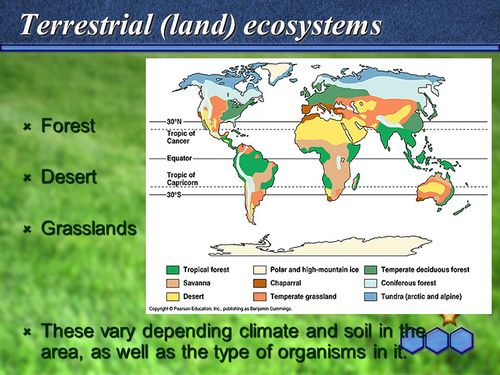
Tundra: Low temperatures and short growing season, which makes for a less productive ecosystem.
Grassland: Hot summers and cold winters, precipitation plays a vital role in the productivity within this biome.
Desert: Great variability due to the different types of deserts. Low precipitation and productivity solely depends upon the type of desert.
Savanna: Long dry seasons and low amounts of rainfall. Typically are productive due to adaptations of communities. (Ex: Serengeti Plain in Africa)
Tropical: Warm and lots of rainfall. High productivity due to ideal climate conditions and rich soil.
Taiga: Commonly known as Coniferous forests. Long, cold winters and short, cool summers. Productivity is dependent on the season.
Chaparral: Wet winters and dry summers. Low productivity due to long dry summers and low quality in soil. (ex: Mediterranean climate)
Temperate Deciduous Forest: Cool winters and warm summers. Year round precipitation makes for a high productivity.
Polar: Extremely cold temperatures, so cold, the climate averages zero degrees Celsius year-round. Low productivity due to extremely low temperatures.
Factors of Terrestrial Ecosystems
Terrestrial ecosystems can be categorized through biotic and abiotic factors . Biotic factors or biological factors are the autotrophs, heterotrophs, and detrivores of a particular ecosystem. You may remember these as producers or autotrophs, consumers or heterotrophs, and decomposers or detrivores. These biotic factors evidence the differentiation in ecosystems and biomes, for example and in most cases, an autotroph that typically lives in a cold, wet climate would not be able to survive in a hot, dry climate such as a desert or savanna. Abiotic factors are physical components to a biome and these components affect the biological diversity and factors of the biome. In short, abiotic factors directly affect biotic factors. Abiotic factors are the unique aspects to a particular climate, the type of soil in the region, and the usage of the land.
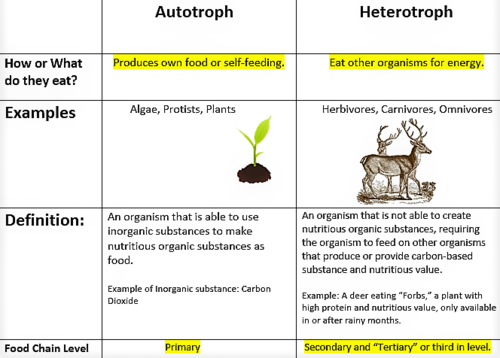
Autotrophs
Autotrophs are organisms that create their own food by converting inorganic compounds into organic compounds. They are primary producers because they reside at the base of the food chain pyramid. There are two types of Autotrophs, Chemoautotrophs and Photoautotrophs.
Chemoautotrophs are bacteria that create energy with the chemical energy within inorganic compounds. This proccess occurs through "chemosynthesis" or the creation of organic compounds by bacteria and these bacteria use energy from chemical reactions that occur without sunlight. They use inorganic compounds like Carbon Dioxide to create sugars. For example, "Sulfur Reducers" are chemoautotrophs and they use inorganic sulfur compounds as a source of energy. Sulfur reducers can be found in locations that release sulfur such as near vents and active volcanoes on the ocean floor. Chemoautotrophs are said to be mainly found within the ocean and in the intestines of animals.
Photoautotrophs are plants and bacteria that contain "chloroplasts" and chloroplasts are able to create energy by converting energy from photons into chemical energy in sugars or other molecules. This occurs in process of photosynthesis. Photoautotrophs play a vital role in terrestrial ecosystems because they are a major provider in energy or food to animals. Plants or photoautotrophs are the primary or base within a food chain pyramid. However there are factors that make each ecosystem unique, so primary or base photoautotrophs will be different within different ecosystems.
Autotrophs can be differentiated by the type of energy they use. Chemoautotrophs use chemical energy and Photoautotrophs use light energy.
Heterotrophs
Heterotrophs are living organisms that gain energy and nutrition through consuming other organisms. The organisms form cells and body parts by using nutrients as "building blocks." Animals and most microorganisms are heterotrophs that can be classified by the organisms they consume. Heterotrophs are secondary and tertiary consumers.
Herbivore: Organisms that eat plants
Example: Deer, Rabbits
Carnivore: Organisms that eat animals
Example: Wolves, Lions
Omnivore: Organisms that eat both plant and animals
Example: Bears, Humans
Detrivores or decomposers that break down plants or animals can also be considered heterotrophic.
References
Beacom, Betsy. 2017, April 25. "Food Chains In Deciduous Forests." https://sciencing.com/food-chains-deciduous-forest-7449795.html
Diffen.com. Diffen LLC.Web."Autotroph vs Heterotroph." https://www.diffen.com/difference/Autotroph_vs_Heterotroph
Freedman, Bill.K. Lee Lerner and Brenda Wilmoth Lerner. The Gale Encyclopedia of Science. 2014."Heterotroph." http://link.galegroup.com/apps/doc/CV2644031108/SCIC?u=sunybuff_main&xid=d35a52f8.
Forseth, Irwin N. 2010. "Terrestrial Biomes" https://www.nature.com/scitable/knowledge/library/terrestrial-biomes-13236757
Gale, World of Biology. 2006. April, 3. "Heterotroph." http://link.galegroup.com/apps/doc/CV2431500310/SCIC?u=sunybuff_main&xid=90cec2db.
Lerner. K Lee. Lerner. Brenda Wilmoth. 2014 The Gale Encyclopedia of Science. "Autotroph." http://link.galegroup.com/apps/doc/CV2644030216/SCIC?u=sunybuff_main&xid=14fc9a52.
National Geographic Society. 2011, January 21. "biome" https://www.nationalgeographic.org/encyclopedia/biome/
